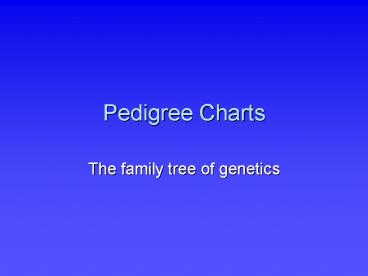Pedigree Charts - PowerPoint PPT Presentation
1 / 23
Title:
Pedigree Charts
Description:
Pedigree Charts The family tree of genetics Patterns of Inheritance When analyzing pedigrees, biologists find certain phenotypes are repeated in predictable patterns ... – PowerPoint PPT presentation
Number of Views:140
Avg rating:3.0/5.0
Title: Pedigree Charts
1
Pedigree Charts
- The family tree of genetics
2
What is a Pedigree?
- A pedigree is a chart of the genetic history of
family over several generations. - Scientists or a genetic counselor would find out
about your family history and make this chart to
analyze.
3
Constructing a Pedigree
- Female
- Male
4
Connecting Pedigree Symbols
Examples of connected symbols
- Married Couple/
- couple with children
- Siblings
5
Example
- What does a pedigree chart look like?
6
Example of Pedigree Charts
- The Shaded shapes means that person has that
trait - They can be homozygous for the trait and if the
trait is a dominant trait they can be
heterozygous for the trait
7
Patterns of Inheritance
- When analyzing pedigrees, biologists find certain
phenotypes are repeated in predictable patterns
from one generation to the next generation - These patterns are called
Patterns of Inheritance
8
Interpreting a Pedigree Chart
- Determine whether the trait is dominant or
recessive. (Remember the dominant traits shows
if there is 1 or 2 alleles RR or Rr, the
recessive shows only if there are 2 recessive
alleles - rr ) - If the trait is dominant, one of the parents must
have the trait. - If the trait is recessive, neither parent has to
have the trait because they can both be
heterozygous.
9
Heterozygous vs. Homozygous
- Remember that an offspring gets one allele for a
trait from each parent thats 2 alleles - If the alleles are the same, we say that
offspring is homozygous the same - If the alleles are different, we say the
offspring is heterozygous different
10
Hetero Homo zygous display
- An example If the offspring has the dominant
trait for tallness (T) from one parent and the
recessive trait (t) from the other, then their
genotype is Tt and they are heterozygous. (They
are still tall) - Some pedigrees split their circles
squares into two and shade them
according to whether the individual
is heterozygous or homozygous.
11
Example of Pedigree Charts
- Dominant or Recessive?
12
Example of Pedigree Charts
- Dominant
Widows peak, Hitchhiker thumb, Cataracts,
Polydactyly, Achondroplasia and Huntingtons
disease are all Dominant traits
13
Example of Pedigree Charts
- Dominant or Recessive?
14
Example of Pedigree Charts
- Recessive
Cystic fibrosis, Tay-Sachs disease, Sickle Cell
Anemia, and Phenylketonuria are all recessive
traits
15
Pedigree vs Punnett Square
- Pedigree
- Follow traits for generations
- Punnett Square
- Predicts the probability of inheriting a trait in
one mating
16
Genetic Disorders
- Diseases or debilitating conditions that have a
genetic basis - These disorders can be caused by
- Single allele inheritance
- Multiple allele inheritance
- Polygenic inheritance
- X-linked inheritance
- Sex-Influenced traits
- Nondisjunction
17
Traits Controlled by a Single Allele
- There are more than 200 human traits that are
determined by only ONE allele - Can be recessive or dominant
- Huntingtons disease is caused b a dominant
allele on an autosome - Emerges in a persons 30s, mild forgetfulness,
irritability, loss of muscle control,
uncontrollable physical spasms, severe mental
illness, and eventually death - 1/10,000 people are affected
- Genetic marker (short DNA segment associated with
the trait) has been identified - Cyctic fibrosis (1/2080 whites), albinism,
Tay-Sachs (1/1600 European descent Jews)
phenylketonuria (1/18,000), and sickle cell
anemia (1/500 Africans) are single allele
recessive traits
18
Traits Controlled by Multiple Alleles
- Controlled by three or more alleles of the same
gene that code for a single trait - ABO blood types in humans
- Each person has 2 of the 3 alleles IA, IB and I
- IA and IB are codominant (both are expressed)
when expressed together
19
Polygenic Traits
- Most human traits are controlled by several genes
- Polygenic traits are controlled by two or more
genes - Skin color is influenced by 3 6 genes each
responsible for an amount of pigment called
melanin - Eyecolor, footsize, and nose length are also
polygenic - Human height is polygenic but also influenced by
the environment (nutrition and disease)
20
X-Linked Traits
- Genes only found on the X chromosome
- X-Linked recessive disorders
- Colorblindness (8 of males)
- Hemophilia impairs blood clotting almost
exclusive in males - Duchenne muscular dystrophy weakens and slowly
destroys muscle tissue
21
Sex-Influenced Traits
- Presence of male or female sex hormones
influences the expression of certain human traits - Pattern baldness is controlled by the B allele,
which is dominant in males BUT recessive in
females - Men and women with BB genotype will lose their
hair - Heterozygous BB men will lose their hair but
women will not - This occurs because of the higher levels of
testosterone in men that interacts with BB
genotype - Most sex influenced trait alleles are on
autosomes and will be expressed by only one sex
22
Disorders Due to Nondisjunction
- Cause organisms to have an extra or a missing
chromosome because chromosomes do not separate
correctly in replication - In humans non-disjunction produces 45 or 47
chromosomes - Monosomy missing 1 chromosome (45/46 in humans)
- Trisomy has 1 extra chromosome (47/46 in humans)
- This is often lethal with a few exceptions
- Down Syndrome Trisomy 21 weak muscles, heart
defects, short stature, facial characteristics,
developmentally delayed - Klinefelters males with XXY males with
feminine characteristics, infertile and sometimes
mental retardation - Turners syndrome females with X females that
do not sexually mature, infertile
23
Summary
- Pedigrees are family trees that explain genetic
history. - Pedigrees are used to determine the probability
of a child having a certain trait in a particular
family
- .































